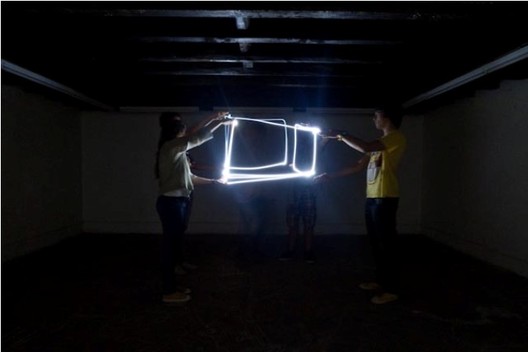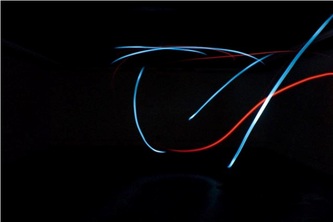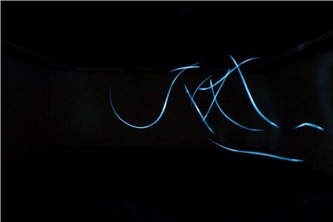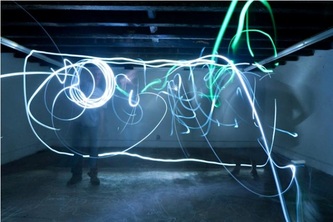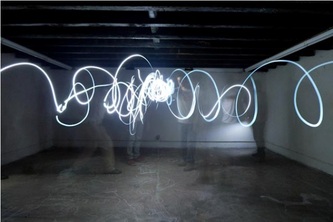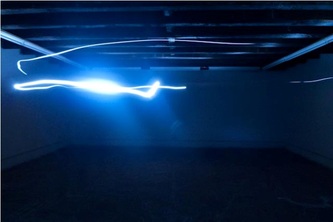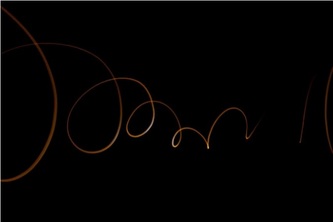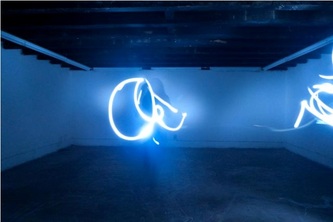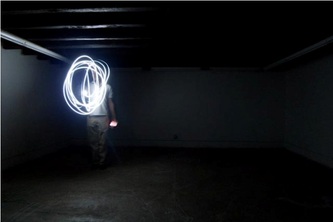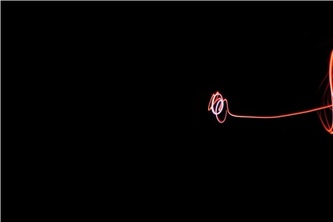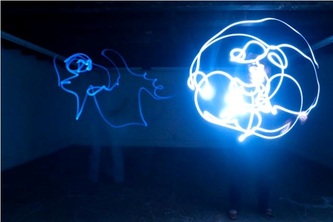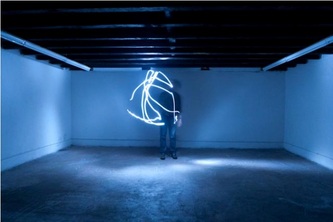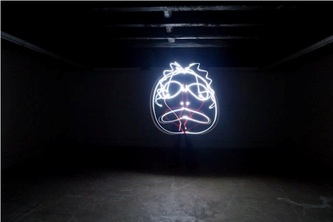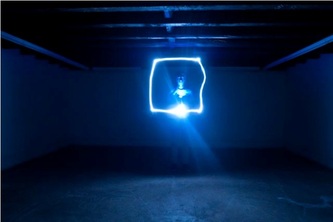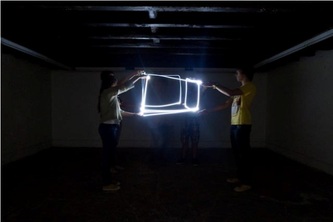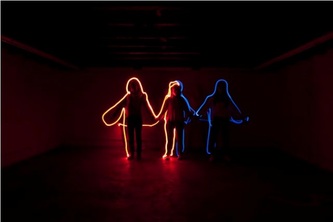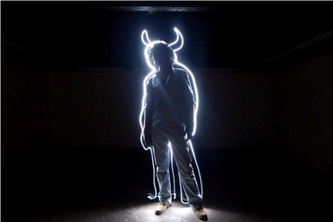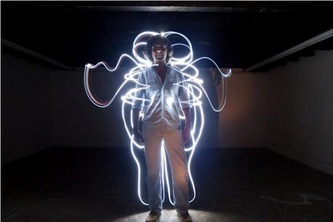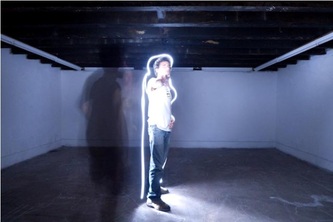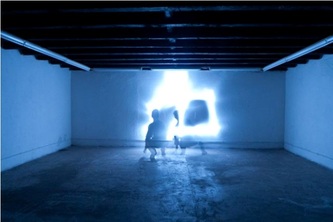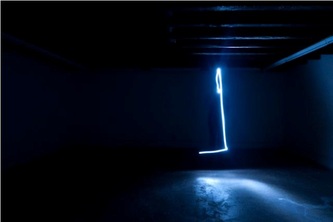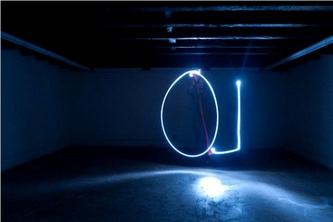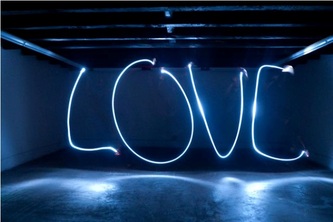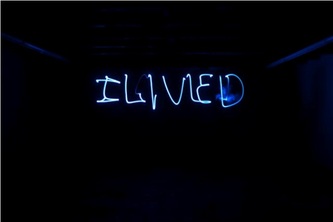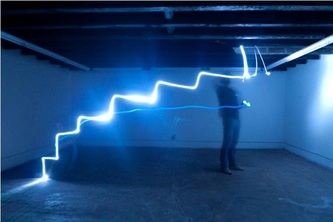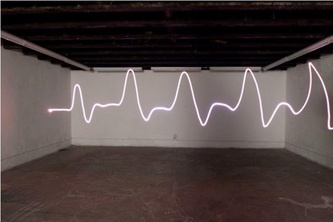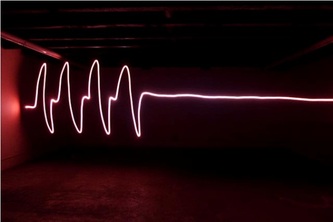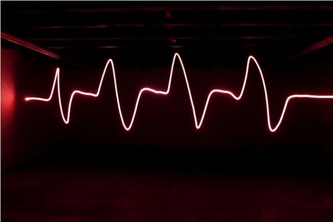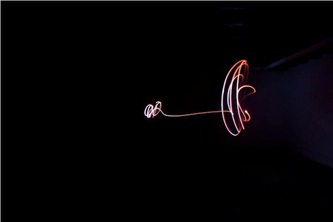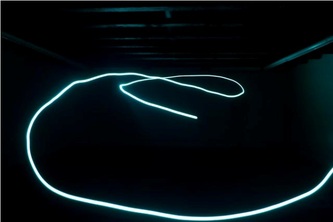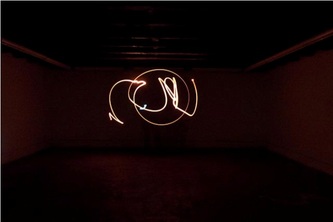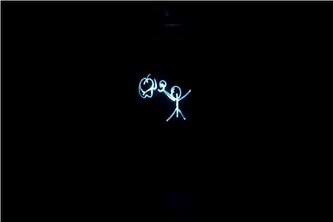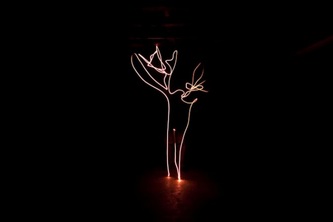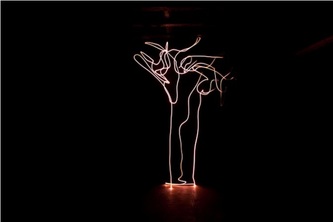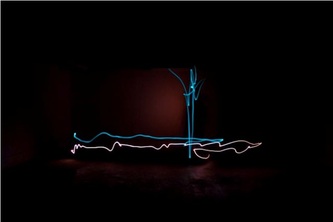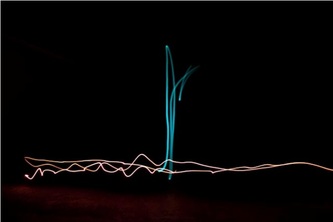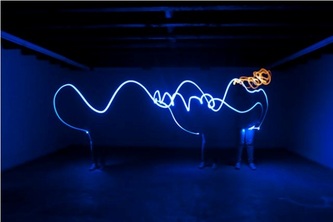_© All rigths reserved to Associação Espaços do
Desenho-Drawing Spaces. Text.Sound.Video.Images
_ Drawing with light
WORKSHOP Developed as a response to the project
‘It is forbidden to draw on paper!’ by pedro janeiro
(artist residency which took place at Drawing Spaces during May/April 2011)
Drawing Spaces, Lisbon, Portugal
14 APRIL 2011
WORKSHOP Developed as a response to the project
‘It is forbidden to draw on paper!’ by pedro janeiro
(artist residency which took place at Drawing Spaces during May/April 2011)
Drawing Spaces, Lisbon, Portugal
14 APRIL 2011
REPORT 17 -
IDEAL
Intercultural Drawing for European Adult Learning
Intercultural Drawing for European Adult Learning
WHAT
A workshops proposing to use different colour artificial lights to draw in a dark room using long exposures made through a photographic camera to register the gestures and movements in drawings made in space and time.
WHERE
Drawing Spaces, Fábrica de Braço de Prata, Lisbon, Portugal.
WHEN
14 April 2011, Thursday, 19h00-23h00
WHO
Facilitators and Staff
Pedro António Janeiro (Artist in Residence in Drawing Spaces at the time of the workshop)
Guida Casella
Ivo Covaneiro
Carla Rebelo
Pedro Gonçalves
ADULT LEARNERS
18 young Female and Male adults, with an age range between 19 and 25 years old.
(This workshop was open to anyone)
WHY
Pedro Janeiro’s personal research on “drawing outside the paper” was the motto for his Artistic Residency at Drawing Spaces. His personal artistic work at the point when this activity took place was based on making drawings on three-dimensional surfaces, such as his or other people’s hands or parts of the body. Hence, this activity was part of a series of 4 workshops that took place during the residency which were proposed to the public and oriented by the artist in residency and focused on drawing on ‘surfaces’ other than paper.
Drawing with Light was a way of enabling the participants to explore their gestures and movements in drawing, in space and time, captured through long photographic exposures.
HOW
For this activity the back room of Drawing Spaces was totally blacked out to enable the capturing of images through long photographic exposures produced using different colour lights. The long photographic exposures were used to ‘fix’ and materialize the images produced in space and time.
VALUE FOR LEARNERS
Learners were a bit intimidated at the beginning of the workshop. Apart from being placed ‘in the dark’ clearly this exercise did not asked for a solitary action of drawing individually in a piece of paper. In order for the drawing to appear as an image after a long photographic exposure, it was necessary that the participants acted somehow in front of a camera, and ultimately in front of the rest of the participants, in this case, their ‘audience’.
Thus, it took a while for people to feel comfortable with the proposed project, and be willing to move their lights freely and expressively in front of the camera, as well as in front of the rest of the participants.
Here, it was particularly important for the learners to trust the examples provided by facilitators and to start to come forward to collaborate in the workshop.
This kind of drawing exercise proved to be quite relevant in terms of how drawing can be used for engaging participant participants in ‘acting out’. In other words, this activity proved to be a good exercise to overcome personal barriers related to moving and acting among others and to become one with the group.
VALUE FOR THE FACILITATORS
The facilitators understood their role as having to be prepared and at ease to give the first steps in the proposed actions to ‘break the ice’ in an activity particularly intimidating for the participants. Much more than just providing instructions and delivering feedback, becoming ‘part of the group’ showed to be of extreme relevance for the participation of people in the activity.
Facilitators became more aware that learners are not always comfortable to participate in certain activities, particularly when they don’t understand exactly the expectations of the projects or when they are invited to participate in less familiar exercises.
That facilitators understood that the engagement of the participants need to be encouraged and accompanied step by step, including looking at the recorded images throughout the process, to enable the participants to become progressively more active while enjoying the activity with less expectations and more will to experiment.
It became clear that the role of the facilitators was not only to provide instructions or to transmit specific background, but also to include themselves as participants in the project. This workshop also demonstrated that if this had not been very clear to participants, the might have not feel so willing to risk ‘to give’ themselves to the project.
VISUAL RECORDS
A workshops proposing to use different colour artificial lights to draw in a dark room using long exposures made through a photographic camera to register the gestures and movements in drawings made in space and time.
WHERE
Drawing Spaces, Fábrica de Braço de Prata, Lisbon, Portugal.
WHEN
14 April 2011, Thursday, 19h00-23h00
WHO
Facilitators and Staff
Pedro António Janeiro (Artist in Residence in Drawing Spaces at the time of the workshop)
Guida Casella
Ivo Covaneiro
Carla Rebelo
Pedro Gonçalves
ADULT LEARNERS
18 young Female and Male adults, with an age range between 19 and 25 years old.
(This workshop was open to anyone)
WHY
Pedro Janeiro’s personal research on “drawing outside the paper” was the motto for his Artistic Residency at Drawing Spaces. His personal artistic work at the point when this activity took place was based on making drawings on three-dimensional surfaces, such as his or other people’s hands or parts of the body. Hence, this activity was part of a series of 4 workshops that took place during the residency which were proposed to the public and oriented by the artist in residency and focused on drawing on ‘surfaces’ other than paper.
Drawing with Light was a way of enabling the participants to explore their gestures and movements in drawing, in space and time, captured through long photographic exposures.
HOW
For this activity the back room of Drawing Spaces was totally blacked out to enable the capturing of images through long photographic exposures produced using different colour lights. The long photographic exposures were used to ‘fix’ and materialize the images produced in space and time.
- After providing a short description to the participants of the overall project of Drawing Spaces, Pedro Janeiro, the artist in residency, introduced his plan for the workshop in relation to his residency at Drawing Spaces.
- Participants were then taken to the darkened room, and set the camera on a tripod and made some tests until the ideal time of exposure was found to enable the capturing of drawings made with colour lights in time and space. It was agreed by the group that around 60 seconds was an appropriate time for the first set of experiences.
- Pedro Gonçalves was the facilitator responsible for controlling the exposures of the digital camera while enabling the participants to engage with this part of the process
- After this, longer exposures were also used while the participants drew individually or in group with different colour lights in space and time.
- Each participant was asked to bring to the workshop a light and coloured mylar paper which was placed in front of the lights in order to get different colour lines (otherwise all the lines would appear just white in the captured images).
- To start with, Pedro Janeiro asked the participants to ‘perform’ anything in front of the camera without previous notice to the rest of the participants and facilitators of what kind of gesture or movement they would be doing. The beginning of the workshop was slow and shy. Participants didn’t feel 100% confident as they were waiting for others to take the first step. Facilitators were very helpful at this occasion, as they performed the first movements with lights in front of the photographic camera, demystifying the expectations on the results, and just allowing the participants to enjoy the playfulness and expressiveness of drawing with lights in space and tracing their movements over time.
- After each exposure, people gathered around the digital camera which had a screen that allowed the display of the resultant image and the appreciation and analysis of the results almost immediately after ‘performing’ the drawings. This was quite important as a strategy of the activity as it enabled the participants to see the results of their gestures and movements and start to become more conscious and controlling of their drawing actions. Facilitators noted that this part of the workshop could be improved on future sessions by having a over-head projector connected to the camera to display the images instead of the small camera screen.
- For the second part of the session, Pedro Janeiro asked the participants to attempt to draw more controlled shapes, individually and in group. This part of the session was extremely interesting as the participants started to interact more with one another, while planning and choreographing their gestures in small groups.
- The analysis and control of actions were done as in the first part of the session, by observing the fixation of images in the photographic screen after each long exposure.
- For the last part of the session, Pedro Janeiro asked the participants to concentrate on what could be the last thing they would draw before they died. This proposition allowed the participants to take a further step in the workshop while assuming a more dramatic and personal response to the performed gesture in drawing.
- As one could observe from the resultant images, the actions became quite expressive and intensive. Having such a theme to base their actions, made the participants more active and participative.
- For this last part of the activity, it was agreed that the images were only to be revealed and seen at the end of the session, when each participant had performed his/her ‘last’ gesture.
- The results were then seen by all as a sequence of images, and participants and facilitators engaged on a final discussion about techniques, actions, effects and results, and also on the experience of drawing in space over time.
VALUE FOR LEARNERS
Learners were a bit intimidated at the beginning of the workshop. Apart from being placed ‘in the dark’ clearly this exercise did not asked for a solitary action of drawing individually in a piece of paper. In order for the drawing to appear as an image after a long photographic exposure, it was necessary that the participants acted somehow in front of a camera, and ultimately in front of the rest of the participants, in this case, their ‘audience’.
Thus, it took a while for people to feel comfortable with the proposed project, and be willing to move their lights freely and expressively in front of the camera, as well as in front of the rest of the participants.
Here, it was particularly important for the learners to trust the examples provided by facilitators and to start to come forward to collaborate in the workshop.
This kind of drawing exercise proved to be quite relevant in terms of how drawing can be used for engaging participant participants in ‘acting out’. In other words, this activity proved to be a good exercise to overcome personal barriers related to moving and acting among others and to become one with the group.
VALUE FOR THE FACILITATORS
The facilitators understood their role as having to be prepared and at ease to give the first steps in the proposed actions to ‘break the ice’ in an activity particularly intimidating for the participants. Much more than just providing instructions and delivering feedback, becoming ‘part of the group’ showed to be of extreme relevance for the participation of people in the activity.
Facilitators became more aware that learners are not always comfortable to participate in certain activities, particularly when they don’t understand exactly the expectations of the projects or when they are invited to participate in less familiar exercises.
That facilitators understood that the engagement of the participants need to be encouraged and accompanied step by step, including looking at the recorded images throughout the process, to enable the participants to become progressively more active while enjoying the activity with less expectations and more will to experiment.
It became clear that the role of the facilitators was not only to provide instructions or to transmit specific background, but also to include themselves as participants in the project. This workshop also demonstrated that if this had not been very clear to participants, the might have not feel so willing to risk ‘to give’ themselves to the project.
VISUAL RECORDS
